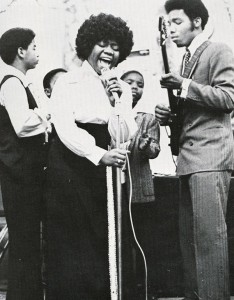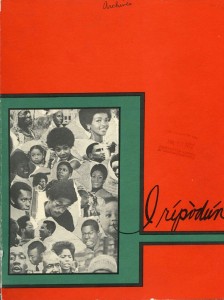In February 1969, the Black Student Association submitted a list of demands to university administration. Also published in BSA’s newspaper The Black Rap, the list called for “The immediate establishment of a Black cultural center large enough to accommodate all Black people which will be run by the Black Student Association.” [1] Shortly after the list was published, Chancellor J.W. Peltason asked Clarence Shelley, Director of the Special Educational Opportunities Program, to “undertake immediately the development of recommendations for establishment of a black cultural center.”[2]
The Faculty-Student Commission on Afro-American Life and Culture was quickly formed and tasked with planning the cultural center and defining its mission. The Commission laid out three major objectives for the center:
- “To encourage within black students on the University and within black people from the larger community a growing sense of pride and dignity based on their rightful cultural heritage, and to assist them in acquiring a growing cultural awareness contributive to the advancement and freedom of black people everywhere.”
- “To create within the University a quantity of valuable information about and talent related to the black experience so that the University, as well as the entire community of Champaign-Urbana, may be afforded an objective, accurate interpretation of that experience through the performing arts, classes and seminars, and other appropriate media.”
- “To assist the University community in understanding the relevance, the efficacy, and the strength of the black experience and to provide a cultural feedback of that experience in terms which will encourage non-blacks to understand the effectiveness of their own performance.”[3]
By the fall of 1969, the Afro-American Cultural Center had opened in a temporary headquarters under the direction of Val Gray Ward, an activist and artist.[4] The Center hosted workshops, classes, and discussions and was a home for the Black Student Association and other black student groups. The Center had several directors during its earliest years who all grew the program’s prominence on campus and in the community. Tony Zamora, the second director, expanded the staff from one single position to a team of two assistant directors, several office assistants, multiple graduate students, a historian, and two librarians.[5] His successor, Robert Ray, organized the Lab Band, which played to crowds of 1,200 students, and the Black Chorus, which continues to be a fixture on campus today.[6]
Taking cues from the Black Arts Movement, The Afro-American Cultural Center became an example of creativity on campus. Students and community members could participate in African dance classes, creative writing workshops, musical groups, and theatrical performances. A number of political and artistic publications were produced under the direction of the Black Student Association and the Afro-American Cultural Center. Irepodun served as an alternative to the Illio and was devoted to illustrating and celebrating black student culture. It featured profiles of Black faculty members, poetry, images of Black cultural events and student groups, and portraits of Black seniors. Irepodun editor Brother Woody described the publication as a “graphical/pictorial/literary Afrikan Continuum.”[7] Recounting the origins of the publication’s title he wrote, “Irepodun translated means ‘unity is a must.’ We derive the meaning from one of the original Afrikan languages, Yoruba. If we as students and future Black ‘professionals’ are to survive and attain self-determination for our Black Nation, then most certainly unity is a must- within ourselves, family, community and people.”[8]
In 1974, Bruce D. Nesbitt became the fourth director of the Afro-American Cultural Center. He served in this role for 22 years. During this time, the Center flourished and began many of the programs that still define it today. Nesbitt was dedicated to improving and enriching the lives of Black students and community members, serving as a mentor and role model to many. In 2004, the Center was renamed the Bruce D. Nesbitt African American Cultural Center.[9]
Today the Center “provides a network of programs and support services promoting the individual, social, cultural, and academic well-being of Illinois’ African American students” and aims to “challenge all Illinois students to critically assess their role as global citizens and to consciously advocate for a respectful campus environment and community.”[10]
The Bruce D. Nesbitt African American Cultural Center Subject File (Record Series 41/12/18) and the Black Student Association Publications (Record Series 41/66/826) are available for research at the Student Life and Culture Archives.
[1] “We Demand” The Black Rap, February 1969. Black Student Association Publications, 1967-, RS 41/66/826, Box 1, University of Illinois Archives.
[2] Simon, Roger “Agree to Cultural Center, Pick Shelley as Director” The Daily Illini, 18 February 1969.
[3] Roth, Barb “Love, Respect, Unity: Black Center Open” The Daily Illini, 1 August 1970.
[4] Williamson, Joy Ann Black Power on Campus: The University of Illinois 1965-75, Urbana-Champaign: University of Illinois Press, 2003.
[6] Roberts, Jeffrey “Black Cultural Program” Irepodun, 1972. Black Student Association Publications, 1967-, RS 41/66/826, Box 1, University of Illinois Archives.
[7] “From the Body Collective” Irepodun, 1973. Black Student Association Publications, 1967-, RS 41/66/826, Box 1, University of Illinois Archives.
[9] “Who’s Bruce?” Bruce D. Nesbitt African American Cultural Center
[10] “Mission & Goals” Bruce D. Nesbitt African American Cultural Center






